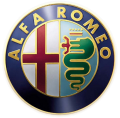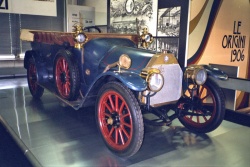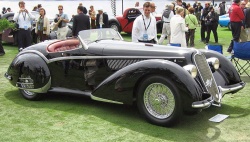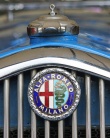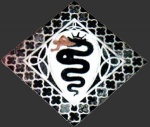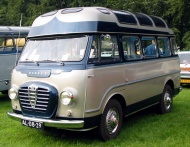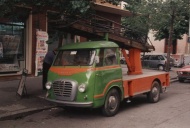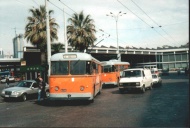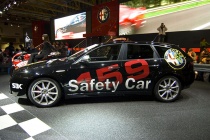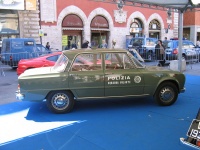Alfa Romeo
Foundation and early years
The company that became Alfa Romeo was founded as Società Anonima Italiana Darracq (SAID) in 1906 by the French automobile firm of Alexandre Darracq, with some Italian investors. One of them, Cavaliere Ugo Stella, an aristocrat from Milan, became chairman of the SAID in 1909. The firm's initial location was in Naples, but even before the construction of the planned factory had started, Darracq decided late 1906 that Milan would be a more suitable location and accordingly a tract of land was acquired in the Milan suburb of Portello, where a new factory of 6700m2 was erected. Late 1909, the Italian Darracq cars were selling slowly and Stella, with the other Italian co-investors, founded a new company named A.L.F.A. (Anonima Lombarda Fabbrica Automobili), initially still in partnership with Darracq. The first non-Darracq car produced by company was the 1910 24 HP, designed by Giuseppe Merosi, hired in 1909 for designing new cars more suitable to the Italian market. Merosi would go on to design a series of new A.L.F.A. cars with more powerful engines (40-60 HP). A.L.F.A. also ventured into motor racing, drivers Franchini and Ronzoni competing in the 1911 Targa Florio with two 24 HP models. In 1914, an advanced Grand Prix car was designed and built, the GP1914 which featured a four cylinder, double overhead camshafts, four valves per cylinder and twin ignition. However, the onset of World War I halted automobile production at ALFA for three years.
| Year | Cars | Industrial vehicles |
|---|---|---|
| 1934 | 699 | 0 |
| 1935 | 91 | 211 |
| 1936 | 20 | 671 |
| 1937 | 270 | 851 |
| 1938 | 542 | 729 |
| 1939 | 372 | 562 |
In August 1915 the company came under the direction of Neapolitan entrepreneur Nicola Romeo, who converted the factory to produce military hardware for the Italian and Allied war efforts. Munitions, aircraft engines and other components, compressors and generators based on the company's existing car engines were produced in a vastly enlarged factory during the war. When the war was over, Romeo invested his war profits in acquiring locomotive and railways carriage plants in Saronno (Costruzioni Meccaniche di Saronno), Rome (Officine Meccaniche di Roma) and Naples (Officine Ferroviarie Meridionali), which were added to his A.L.F.A. ownership. Car production had not been considered at first, but resumed in 1919 since parts for the completion of 105 cars were still lying at the A.L.F.A. factory since 1915. In 1920, the name of the company was changed to Alfa Romeo with the Torpedo 20-30 HP becoming the first car to be badged as such.Their first success came in 1920 when Giuseppe Campari won at Mugello and continued with second place in the Targa Florio driven by Enzo Ferrari. Giuseppe Merosi continued as head designer, and the company continued to produce solid road cars as well as successful race cars (including the 40-60 HP and the RL Targa Florio).
In 1923 Vittorio Jano was lured away from Fiat, partly thanks to the persuasion of a young Alfa racing driver named Enzo Ferrari, to replace Merosi as chief designer at Alfa Romeo. The first Alfa Romeo under Jano was the P2 Grand Prix car, which won Alfa Romeo the inaugural world championship for Grand Prix cars in 1925. For Alfa road cars Jano developed a series of small-to-medium-displacement 4, 6, and 8 cylinder inline power plants based on the P2 unit that established the classic architecture of Alfa engines, with light alloy construction, hemispherical combustion chambers, centrally-located plugs, two rows of overhead valves per cylinder bank and dual overhead cams. Jano's designs proved to be both reliable and powerful.
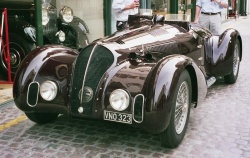
Enzo Ferrari proved to be a better team manager than driver, and when the factory team was privatised, it then became Scuderia Ferrari. When Ferrari left Alfa Romeo, he went on to build his own cars. Tazio Nuvolari often drove for Alfa, winning many races prior to World War II.
In 1928 Nicola Romeo left, with Alfa going broke after defense contracts ended, and in the end of 1932 Alfa Romeo was rescued by the government, which then had effective control. Alfa became an instrument of Mussolini's Italy, a national emblem. During this period Alfa Romeo built bespoke vehicles for the wealthy, with the bodies normally built by Touring of Milan or Pininfarina. This was the era that peaked with the legendary Alfa Romeo 2900B Type 35 racers.
The Alfa factory (converted during wartime to the production of Macchi C.202 Folgore engines) was bombed during World War II, and struggled to return to profitability after the war. The luxury vehicles were out. Smaller mass-produced vehicles began to be produced in Alfa's factories beginning with the 1954 model year, with the introduction of the Giulietta series of berline (saloons/sedans), coupes and open two-seaters. All three varieties shared what would become the classic Alfa Romeo Twin Cam engine, initially in 1300 cc form. This engine would eventually be enlarged to just under 2 liters (1962 cc) and would remain in production through 1995.

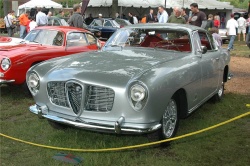
Post war
Once motorsports resumed after World War II, Alfa Romeo proved to be the car to beat in Grand Prix events. The introduction of the new formula (Formula One) for single-seat racing cars provided an ideal setting for Alfa Romeo's tipo 158 Alfetta, adapted from a pre-war voiturette, and Giuseppe Farina won the first Formula One World Championship in 1950 in the 158. Juan Manuel Fangio secured Alfa's second consecutive championship in 1951. During the 1960s, Alfa concentrated on competition using production-based cars, including the GTA (standing for Gran Turismo Allegerita), an aluminum-bodied version of the Bertone-designed coupe with a powerful twin-plug engine. Among other victories, the GTA won the inaugural Sports Car Club of America's Trans-Am championship in 1966. In the 1970s, Alfa concentrated on prototype sports car racing with the Tipo 33, with early victories in 1971. Eventually the Tipo 33TT12 gained the World Championship for Makes for Alfa Romeo in 1975 and the Tipo 33SC12 won the World Championship for Sports Cars in 1977.
By the 1970s Alfa was again in financial trouble. The Italian government company Finmeccanica bowed out in 1986 as Fiat Group bought in, creating a new group, Alfa Lancia Industriale S.p.A., to manufacture Alfas and Lancias. Models produced subsequent to the 1990s combined Alfa's traditional virtues of avant-garde styling and sporting panache with the economic benefits of product rationalisation, and include a "GTA" version of the 147 hatchback, the Giugiaro-designed Brera, and a high-performance exotic called the 8C Competizione (named after one of Alfa's most successful prewar sports and racing cars, the 8C of the 1930s).
In 2005 Maserati was bought back from Ferrari and brought under Fiat's full control. The Fiat Group plans to create a sports and luxury division from Maserati and Alfa Romeo. There is a planned strategic relationship between these two; engines, platforms and possibly dealers will be shared in some market areas.
In the beginning of 2007, Fiat Auto S.p.A. was reorganized and four new automobile companies were created; Fiat Automobiles S.p.A., Alfa Romeo Automobiles S.p.A., Lancia Automobiles S.p.A. and Fiat Light Commercial Vehicles S.p.A. These companies are fully owned by Fiat Group Automobiles S.p.A.
The history of the Alfa Romeo badge
In 1910 a draughtsman named Romano Cattaneo was given the job of coming up with a badge for a new Milan-based company, ALFA. The story goes that as he was waiting for a train at the Piazza Castello terminus in Milan, he gained inspiration from the red cross and off the coat of arms and flag of Milan and the Visconti family's biscione (human child-bearing serpent) coat of arms emblazoned over the great door of Castello Sforzesco.
In 1918 after the company was purchased by Nicola Romeo, the badge was redesigned with the help of Giuseppe Merosi, including now the City of Milan's emblem and that of the Visconti family in a circular motif, bordered by a dark blue metallic ring containing the inscription "ALFA — ROMEO" and "MILANO" separated by two Savoy dynasty knots to honour the Kingdom of Italy.
After the victory of the P2 in the inaugural Automobile World Championship in 1925, Alfa added a laurel wreath around the logo.
In 1946 after the victory of the Italian Republic Savoy knots were replaced with two curvy lines.
The name "MILANO", the hyphen and the Savoy knots (lines) were eliminated when Alfa Romeo opened the factory at Pomigliano d'Arco, Naples in early 1970s.
Racing history
Main Article: Alfa Romeo in motorsport

Alfa Romeo scored many prestigious victories in all the different categories: Formula 1, Prototypes, Touring and Fast Touring. Private drivers also ran some rally competitions with fine results.
In 1923 Vittorio Jano was lured to Alfa from Fiat, designing the motors that gave Alfa racing success into the late thirties. (When Alfa began to lose in the late thirties Jano was promptly sacked.)
In the 1930s, Tazio Nuvolari won the Mille Miglia in a 6C 1750 [1], crossing the finishing line after having incredibly overtaken Achille Varzi without his lights (at nighttime).
The 8C 2300 won the Le Mans 24 Hours from 1931 to 1934, with Alfa Romeo withdrawing from racing in 1933, when the Italian government took over, and the racing of Alfas was then taken up by Scuderia Ferrari as Alfa's outsourced team. (Enzo Ferrari drove for Alfa, before he went on to manage the team, and after that, went on to manufacture his own cars.) In 1935 Alfa Romeo won the German Grand Prix with Nuvolari. In 1938 Biondetti won the Mille Miglia in a 8C 2900B Corto Spyder, thereafter referred to as the "Mille Miglia" model.
In 1950 Nino Farina won the Formula One World Championship in a 158 with compressor, in 1951 Juan Manuel Fangio won while driving a Alfetta 159 (an evolution of the 158 with a two-stages compressor). Other titles won in 1975 and 1977, while the 33 dominated the Prototype category from 1967 to 1977.
In the 1960s Alfa Romeo became famous for its small cars and models specifically designed for the Italian police ("Panthers") and Carabinieri; among them the glorious "Giulia Super" - [2]. Or the 2600 Sprint GT, which obtained an expressive nickname of "Inseguimento" (this car is wrongly supposed to be the one that the famous Roman police Marshall and unrivaled driver Armandino Spadafora brought down on the Spanish Steps in 1960 while following some robbers - it was instead a black Ferrari 250 GT/E - this pic of Giulia [3], one of the dozens about this legend, is taken from a movie and not at Spanish Steps).
After the 1970s, economic issues caused the government to finally sell Alfa Romeo to Fiat in 1986, which still own it.
Before being bought by Fiat, Alfa Romeo always had a daring commercial policy, constantly experimenting with new solutions and using them in its series production, even at the risk of losing market share. Alfa often used controversial and unorthodox styling too, which often challenged one's assumptions about styling.
On an English sales brochure:
- The Alfa Romeo Giulia 1600 SS - For the man who has everything, here is the car to keep him company. ... The price is GBP 2394.1.3 including tax. Expensive? Naturally! What else would you expect a hand-built Alfa to be? [4]
It represented the make of those cars which could allow some sporty driving on common roads, provided the driver was enthusiast enough to appreciate their particular "sound".
One owner of an A.R. is an "Alfista", and a group of them are "Alfisti", in Italian. Alfa Romeo is sometimes worshiped by its owners, and many models have become cultural symbols. There are many thriving Alfa Romeo owners clubs and Alfa Romeo Model Registers.
In 1967 the famous Dustin Hoffman's film "The Graduate" gave worldwide unforgettable celebrity to the "Spider" (best known with the Italian nickname of "Duetto", or as "Osso di Seppia" or Round-tail), and its unique shape. The Spider was designed by Pininfarina.
RHD Alfa Romeo Production post-1960
In the late 1960's, a number of European automobile manufacturers established facilities in South Africa to assemble right hand drive vehicles for the Commonwealth markets. Fiat and other Italian manufacturers established factories along with these other manufacturers in Rosslyn, Pretoria and later in Brits.
With the imposition of sanctions by western powers in the 1970's and 1980's, South Africa became self sufficient, and in car production came to rely more and more on the products of the Uitenhage factories. In consequence, production levels increased, and many manufacturers including Fiat Spa., Lancia, Ferrari and Alfa Romeo transferring all their right-hand drive production to Uitenhage. Volkswagen AG, Daimler Benz AG and BMW AG followed suit at about this time.
Since then, all right-hand-drive production of Alfa Romeo (and most other European manufacturers) remains in Uitenhage - so that RHD European cars are actually South African in origin, or else have their steering and dashboard assemblies produced there.
Production
| Year | Cars |
|---|---|
| 1998 | 197,680 |
| 1999 | 208,336 |
| 2000 | 206,836 |
| 2001 | 213,638 |
| 2002 | 187,437 |
| 2003 | 182,469 |
| 2004 | 162,179 |
| 2005 | 130,815 |
| 2006 | 157,794 |
| 2007 | 151,898 |
| 2008 | 103,097 |
| 2009 | 103,687 |
| 2010 | 119,451 |
| 2011 | 130,535 |
| 2012 | 101,000 |
| 2013 | 74,000 |
| 2014 | 58,948 (EU sales) |
| 2015 | 56,688 (EU sales) |
| 2016 | 93,117 |
| 2017 | 150,722 |
Until the 1980s, Alfa Romeos, except for the Alfasud, were rear-wheel-drive.
According to the current Fiat CEO Sergio Marchionne in order to reap economies of scale, all new Alfa Romeo models will be made from the same basic platform (i.e., frame). Even Maserati will share components with some Alfas.
Cloverleaf, or Quadrifoglio, badges denote high-end in comfort and engine size variants of Alfa Romeo cars, but previously denoted Alfa Romeo racing cars in the pre-Second-World-War era. The image first appeared in 1923 when Ugo Sivocci presented one prior to the start of the 14th Targa Florio as a good luck token to the team. This became the symbol of competition Alfas, denoting higher performance. Some modern Alfas wear a cloverleaf badge which is typically a green four leaf clover on a white background (Quadrifoglio Verde), but variants of blue on white have been recently observed as well.
The Alfettas of the early 1980s had models available sold as the "Silver Leaf" and "Gold Leaf" (Quadrifoglio Oro). These models were the top of the range. Badging was the Alfa Cloverleaf in either gold or silver to denote the specification level. The Gold Leaf model was also sold as the "159i" in some markets, the name in homage to the original 159.
The trim levels (option packages) offered today on the various nameplates (model lines) include the lusso ("luxury"), turismo ("touring"), and the GTA (gran tourismo alleggerita ("light-weight grand tourer"). The GTA package is offered in the 147 and 156 and includes a V-6 engine. In the past, Alfa Romeo offered a Sprint (from Italian sprintare, "to accelerate fast") trim level.
During the 1990s, Alfa Romeo moved car production to other districts in Italy. The Pomigliano d’Arco plant produced the 155, followed by the 145 and the 146, while Arese manufactured the 164 and new Spider and GTV. The 156 was launched in 1997, and became quite successful for Alfa Romeo; in 1998 it was voted “Car of the Year”. The same year a new flagship, the 166 (assembled in Rivalta, near Turin) was launched. At the beginning of the third millennium, the 147 was released, which won the prestigious title of “Car of the Year 2001”. In 2003 the Arese factory is closed.
The 155, 156, and GTV/Spider are no longer produced. The GTV/Spider was made in limited numbers, and is still a sought after model.
The Arese factory today hosts almost nothing and is nearly abandoned. What remains are some offices and the great Alfa Romeo Historical Museum, a must-see for Alfa Romeo fans.
Engines
| Years | Engine | Cylinders |
|---|---|---|
| 1954–1994 | Twin Cam | 1290, 1570, 1750, 1779, 1962 |
| 1992–present | TwinSpark | 1.4, 1.6, 1.7, 1.8, 2.0 |
| 1971–1995 | Flat-4 | 1186, 1286, 1350, 1490, 1712 |
| 1979–2006 | V6 | 2.0, 2.5, 3.0, 3.2 |
| 2006–present | GM based V6 | 3.2 |
- History of the Alfa Race Engine (Four Of The Greatest).
Other production
Aircraft engines
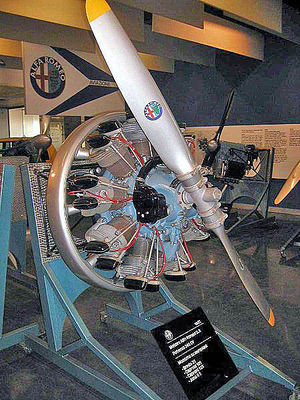
An Alfa engine was first used on an aircraft in 1910 on the Santoni-Franchini biplane. In 1932 Alfa Romeo built its first real aircraft engine the D2 (240 bhp), which was fitted to Caproni 101 D2. In the 1930s when Alfa Romeo engines were used for aircraft on a larger scale; the Savoia Marchetti SM.74, Savoia-Marchetti SM.75, Savoia-Marchetti SM.79, Savoia Marchetti SM.81 and Cant Z506B Airone all used Alfa Romeo manufactured engines. In 1931, a competition was arranged where Tazio Nuvolari drove his Alfa Romeo 8C 3000 Monza against a Caproni Ca.100 airplane. Alfa Romeo built various aircraft engines during World War II; the best known was the RA.1000 RC 41-I Monsone, a licensed version of the Daimler-Benz DB 601. This engine made it possible to build efficient fighter aircraft like the Macchi C.202 Folgore for the Italian army. After World War II Alfa Romeo produced engines for Fiat, Aerfer and Ambrosini. In the 1960s Alfa Romeo mainly focused upgrading and maintaining Curtiss-Wright, Pratt & Whitney, Rolls-Royce and General Electric aircraft engines. Alfa Romeo built also Italy's first turbine engine, installed to the Beechcraft King Air. Alfa Romeo's Avio division was sold to Aeritalia in 1988, from 1996 it was part of Fiat Avio. Alfa Avio was also part of developing team to the new T700-T6E1 engine to the NHI NH90 helicopter.
Trucks, light commercial vehicles
In 1930 Alfa Romeo presented a light truck in addition to heavy LCVs based to Büssing constructions. In the Second World War Alfa Romeo also built trucks for the Italian army ("35 tons anywhere") and later also for the German Wehrmacht. After the war, commercial motor vehicle production was resumed.
Market demands have often created unique needs for automakers to fill. Having adjusted its market strategy after World War II to mass-produced vehicles, with the occasional coachbuilt custom, Alfa Romeo found itself producing not just sporting automobiles but also railway locomotives, buses, tractors and commercial vans.
Introduced at the 1954 Turin Motor Show, the Romeo Autotutto (“all purpose”), as it was first called, was a panel van and minibus. It was powered by one of two engines: the 1,290 cc 750-series twin-cam that would later power the Giulietta or a diesel engine fitted with a Roots-type supercharger. The Autotuttos were available in a wide variety of packages, including passenger van, cargo van, school bus, pickup truck and, of course, ambulance configurations.
- 78hp, 1,290 cc twin overhead cam four-cylinder engine
- four-speed manual transmission
- four-wheel independent suspension
- front disc brakes
An update in the late 1950s saw the Autotutto become the “Romeo 2” van and a subsequent update renamed the Romeo 2 to F12 (lighter duty) and A12 (heaviest duty). By 1966, the Giulia 1300’s sonorous twin-cam engine and ATE front disc brakes had become standard equipment. An updated, face-lifted body with front-hinged doors rounded out the changes.
The 1968 Alfa Romeo F12 offered here is an exceedingly rare example of one of the most unique vehicles ever produced by Alfa Romeo. Estimates suggest that fewer than 100 Alfa Romeo vans exist to this day and perhaps none are as nicely preserved. Powered by the traditional Alfa Romeo twin overhead cam engine it sports the standard Alfa four-speed gearbox, rear end, suspension, wheels and gauges. It comes complete with crosses, sirens, blue and white interior lights, stretchers, a sink and storage compartments.
In co-operation with FIAT and Saviem starting from the 60s different light truck models were developed. The production of heavy LCVs was terminated in 1967. In Brazil the heavy trucks were built still few years under the name FNM (Fàbrica Nacional de Motores). Last Alfa Romeo vans were Alfa Romeo AR6 and AR8, which were rebadged versions of Iveco Daily and Fiat Ducato. The company also produced trolleybuses, which were used by many cities in Italy. Later, Alfa Romeo concentrated only on passenger car manufacturing. Source
LCVs
- Romeo (1954-1958)
- Romeo 2 (until 1966)
- Romeo 3 (1966)
- A11/F11
- A12/F12 (until 1983)
- AR8 (based on first generation Iveco Daily)
- AR6 (based on first generation Fiat Ducato)
Trucks
- Alfa Romeo 430 (1939, 1942-1950)
- Alfa Romeo 500
- Alfa Romeo 800 (1940-1943)
- Alfa Romeo 900 Truck
- Alfa Romeo 950
- Alfa Romeo Mille (Alfa Romeo 1000)
- Alfa Romeo A19n (Saviem license)
Buses
- Alfa Romeo 430A
- Alfa Romeo 900
- Alfa Romeo 950
- Alfa Romeo Mille (Alfa Romeo 1000)
Trolleybuses
- Alfa Romeo 110AF (1938)
- Alfa Romeo 140AF (1949)
- Alfa Romeo 900
- Alfa Romeo Mille (Alfa Romeo 1000)
Alfa Romeo sponsorships
In 2002 was launched the first Alfa Romeo super maxi yacht and Neville Crichton's new super maxi Alfa Romeo 2 was first tested in 2005, this 30m ship is successor to the world champion of the same name. The first Alfa Romeo super maxi took around 74 wins, including the 2002 Rolex Sydney Hobart Yacht Race.
Alfa Romeo is also sponsoring SBK Superbike World Championship and Ducati Corse since 2007. The Alfa Romeo 159 Sportwagon TI is used as safety car in Superbike World Championship events.
Alfa Romeo in popular culture
In the 1960s Alfa Romeo became famous for its small cars and models specifically designed for the Italian police — "Panthers" and Carabinieri; among them the glorious "Giulia Super" or the 2600 Sprint GT, which acquired the expressive nickname of "Inseguimento" (this car is wrongly supposed to be the one that the famous Roman police marshal and unrivalled driver Armandino Spadafora brought down on the Spanish Steps in 1960 while following some robbers - it was actually a black Ferrari 250 GT/E - this picture of Giulia [5], one of the dozens about this legend, is taken from a movie and not at the Spanish Steps).
Before being bought by Fiat, Alfa Romeo always had a daring commercial policy, constantly experimenting with new solutions and using them in its series production, even at the risk of losing market share. Alfa often used controversial and unorthodox styling too, which often challenged assumptions about styling.
In a British sales brochure:
- The Alfa Romeo Giulia 1600 SS - For the man who has everything, here is the car to keep him company. ... The price is GBP 2394.1.3 including tax. Expensive? Naturally! What else would you expect a hand-built Alfa to be? [6]
It represented those makes of cars that permitted sporty driving on common roads, provided the driver was enthusiastic enough to appreciate their particular "sound".
In Italian the owner of an Alfa Romeo is an "Alfista", and a group of them are "Alfisti". Alfa Romeo is sometimes worshipped by its owners, and many models have become cultural symbols. There are many thriving Alfa Romeo owners clubs and Alfa Romeo Model Registers.
In 1967 the famous Dustin Hoffman film The Graduate gave worldwide unforgettable celebrity to the "Spider" (best known by the Italian nickname of "Duetto", or as "Osso di Seppia," meaning "cuttlefish bone," or Round-tail), and its unique shape [7]. The Spider was designed by Pininfarina; derived from several design studies dating back to the late 1950s, the Spider is believed to be the last design on which Battista Farina personally worked.
Also James Bond (Roger Moore) used an Alfa Romeo, the GTV6 in 1983's Octopussy, where he is pursued by two Bavarian BMW police cars.
In the television crime film series Ein Fall für Zwei ("a case for two", over 250 episodes made so far), the leading actor Claus Theo Gärtner, who plays the role of the private detective Josef Matula, has always been driving Alfa Romeo, starting from Giulia Super to the latest Alfa Romeo models.
Alfa Romeo had also "role" in other German detective serie Kommissar Rex (Inspector Rex). At the beginning Tobias Moretti drove a 155 and later Gedeon Burkhard drove 166.
Michael Corleone (Al Pacino) in The Godfather, drove a magnificent, black Alfa Romeo 6C while in exile in Sicily. This was actually the car that was booby-trapped and explodes with Apollonia, his Sicilian wife, in it toward the end of the movie.
John Malkovich, as Tom Ripley, in Ripley's Game, drives a red Alfa Romeo 156 Sportwagon.
Edward Fox, as the Jackal, in 1973's The Day of the Jackal drives a white Giulietta Spider. He repaints the car blue in a rented garage to avoid police, then crashes the car.
Giulietta Masina in Fellini's Juliet of the Spirits is courted by a "Romeo" in a Giulietta (Spider), a double play on words.
Alfa Romeo Giulias appear as Polizia cars in the 1969 movie The Italian Job. During the chase in Turin they all suffer some sort of fate, from breaking down on top of a building to being washed away by a weir.
Alfa Romeo motorcars are recognised by all Motor enthusiasts as being the first "supercar", with the term being coined in the 1920s by a British journalist to describe an Alfa Romeo. Some notable owners include Beppe Carletti (Musician, Retailer), Jeremy Christian (Classic Track Driver, Writer), Jeremy Clarkson (Motoring Journalist), Alex Hucksley (Actor, Stock Broker), Roger Moore (Actor) and Michael Schumacher (F1 Driver).
In Dan Brown's novel Angels & Demons, the members of the Swiss Guard all drive Alfa Romeo sedans.
List Of Models and Photos
| Alfa Romeo Automobiles S.p.A., a subsidiary of the Fiat S.p.A. since 1986, car timeline, 1910-1949 | Next -> | |||||||||||||||||||||||||||||||||||||||
| Type | 1910s | 1920s | 1930s | 1940s | ||||||||||||||||||||||||||||||||||||
| 0 | 1 | 2 | 3 | 4 | 5 | 6 | 7 | 8 | 9 | 0 | 1 | 2 | 3 | 4 | 5 | 6 | 7 | 8 | 9 | 0 | 1 | 2 | 3 | 4 | 5 | 6 | 7 | 8 | 9 | 0 | 1 | 2 | 3 | 4 | 5 | 6 | 7 | 8 | 9 | |
| 4-cyl. | 12 HP / 15 HP / 24 HP / 15-20 HP / 20-30 HP | 20/30 HP | RM | |||||||||||||||||||||||||||||||||||||
| 4-cyl. | 40/60 HP | |||||||||||||||||||||||||||||||||||||||
| 4-cyl. | ES Sport | |||||||||||||||||||||||||||||||||||||||
| 6-cyl. | G1 / G2 | RL | ||||||||||||||||||||||||||||||||||||||
| 6-cyl. | 6C - 1500 / 1750 / 1900 / 2300 / 2500 | |||||||||||||||||||||||||||||||||||||||
| 8-cyl. | 8C - 2300 / 2600 / 2900 | |||||||||||||||||||||||||||||||||||||||
| Racing car |
GP | P1 / P2 | Tipo A | Tipo B (P3) | Tipo C (8C-35) | Tipo 308 | 158 / 159 Alfetta | |||||||||||||||||||||||||||||||||
| Bi-motore | 12C | Tipo 512 | ||||||||||||||||||||||||||||||||||||||
| <- Previous | Alfa Romeo Automobiles S.p.A., a subsidiary of the Fiat S.p.A. since 1986, car timeline, 1946-1979 | Next -> | ||||||||||||||||||||||||||||||||||||||||||
| Type | 1950s | 1960s | 1970s | |||||||||||||||||||||||||||||||||||||||||
| 0 | 1 | 2 | 3 | 4 | 5 | 6 | 7 | 8 | 9 | 0 | 1 | 2 | 3 | 4 | 5 | 6 | 7 | 8 | 9 | 0 | 1 | 2 | 3 | 4 | 5 | 6 | 7 | 8 | 9 | |||||||||||||||
| Small family car | Dauphine* | Alfasud | ||||||||||||||||||||||||||||||||||||||||||
| Compact executive car | Giulietta (750/101) | |||||||||||||||||||||||||||||||||||||||||||
| Giulia | Giulietta (116) | |||||||||||||||||||||||||||||||||||||||||||
| 1750 | Alfetta | |||||||||||||||||||||||||||||||||||||||||||
| Executive car | 1900 | 2000 | 2600 | 2000 | Alfa 6 | |||||||||||||||||||||||||||||||||||||||
| Cabriolet | 1900 | 2000 | 2600 | |||||||||||||||||||||||||||||||||||||||||
| Coupé | Giulietta | Sprint | ||||||||||||||||||||||||||||||||||||||||||
| Giulia | Alfetta GT/GTV and GTV6 | |||||||||||||||||||||||||||||||||||||||||||
| 1900 | 2000 | 2600 | ||||||||||||||||||||||||||||||||||||||||||
| Roadster | Spider | |||||||||||||||||||||||||||||||||||||||||||
| Gran Sport Quattroruote | ||||||||||||||||||||||||||||||||||||||||||||
| Sports car | …6C 2500 | Montreal | ||||||||||||||||||||||||||||||||||||||||||
| 33 Stradale | ||||||||||||||||||||||||||||||||||||||||||||
| Off-road | Matta | |||||||||||||||||||||||||||||||||||||||||||
| Racing car | TZ/GTA | |||||||||||||||||||||||||||||||||||||||||||
| …158/159 | Tipo 33 | 177 | ||||||||||||||||||||||||||||||||||||||||||
| *Dauphine was produced under Renault license | ||||||||||||||||||||||||||||||||||||||||||||
| <- Previous | Alfa Romeo Automobiles S.p.A., a subsidiary of the Fiat S.p.A. since 1986, car timeline, 1980s-present | ||||||||||||||||||||||||||||||
| Type | 1980s | 1990s | 2000s | ||||||||||||||||||||||||||||
| 0 | 1 | 2 | 3 | 4 | 5 | 6 | 7 | 8 | 9 | 0 | 1 | 2 | 3 | 4 | 5 | 6 | 7 | 8 | 9 | 0 | 1 | 2 | 3 | 4 | 5 | 6 | 7 | 8 | 9 | ||
| Supermini | Junior | ||||||||||||||||||||||||||||||
| Small family car | Alfasud | 33 | 145/146 | 147 | 149 | ||||||||||||||||||||||||||
| Arna | |||||||||||||||||||||||||||||||
| Compact executive car | Alfetta | 75 | 155 | 156 | 159 | ||||||||||||||||||||||||||
| Nuova Giulietta | |||||||||||||||||||||||||||||||
| Executive car | Alfa 6 | 90 | 164 | 166 | 169 | ||||||||||||||||||||||||||
| Coupé | Sprint | GTV (916) | GT | ||||||||||||||||||||||||||||
| GTV | Brera | ||||||||||||||||||||||||||||||
| Cabriolet | Spider (916) | Spider (939) | |||||||||||||||||||||||||||||
| Sportscar | SZ/RZ | ||||||||||||||||||||||||||||||
| Roadster | Spider | ||||||||||||||||||||||||||||||
| Supercar | 8C Competizione and Spider | ||||||||||||||||||||||||||||||
| Racing car | 179/182/183T/184T/185T | SE 048SP | |||||||||||||||||||||||||||||
Alfa Romeo Model Identification
Concept Cars
List of Alfa Romeo concept cars
Concept Cars by Italdesign
Designs by Pininfarina
Alfa Romeo 8C (2004)
Return to the United States
In 1995 Alfa Romeo ceased exporting cars to the United States, the last model to be sold being the 164. Rumors began of their return, however as the FAQ on Alfa's English website had said "The long-awaited return of Alfa Romeo to the United States market should take place by 2007, with a range of new models."
Alfa Romeo's return to United States was confirmed on May 5 2006 by Fiat CEO Sergio Marchionne. It will begin in 2008, by selling the 8C Competizione. In late 2009, Alfa Romeo will release the 159, Brera, and Spider after they receive a mid-life styling and technical refreshening. It is anticipated that a year or two later will see the introduction of the Kamal SUV, 169, and possibly the B-segment Mi.To (as a competitor for the MINI Cooper). Alfa Romeos will be initially sold at Maserati dealers throughout United States. An article found at Autoblog claimed that Alfa Romeo and Chrysler are currently in discussions, with Alfa Romeo using Chrysler manufacturing plants that have been shut down due to unneeded product.
An article found at Autoblog on July 8, 2008 stated that MINI dealerships will possibly be partnering with Alfa Romeo to sell Alfas at MINI dealerships, when Alfa is anticipating a return to the USA in 2010.
Internal Links
Automotive Links -- for Parts, Clubs and much more
External links
- Official Alfa Romeo site
- The Alfa Romeo Owners Forum [8]
- The Alfa Romeo Fan Site Alfa-Romeo.com
- Alfa's in the Movies
See also:
| Alfa Romeo Formula One | ||||
|---|---|---|---|---|
| Alfa Romeo SpA (1950-1951): 158, 159, 159A, 159B | Giuseppe Farina, Juan Manuel Fangio
Autodelta (1979): 177 | 179, 179B, 179C, 179D | Bruno Giacomelli, Vittorio Brambilla Marlboro Team Alfa Romeo (1980-1983): 179, 179B, 179C, 179D | 182, 182B | 183T, 183TB | Andrea de Cesaris, Mario Andretti, Bruno Giacomelli, Mauro Baldi Benetton Team Alfa Romeo (1984-1985): 184T, 184TB | 185T, 185TB | Riccardo Patrese, Eddie Cheever ----- Alfa Romeo engine: Brabham BT45/BT45B/BT45C | Brabham BT46/BT46B | Brabham BT48 | McLaren M7D | McLaren M14D | Cooper T53 |
Send what you have to:
| Car Information and Photos by Marque: A - B - C - D - E - F - G - H - I - J - K - L - M - N - O - P - Q - R - S - T - U - V - W - X - Y - Z |
| Motorcycle Information and Photos by Marque: A - B - C - D - E - F - G - H - I - J - K - L - M - N - O - P - Q - R - S - T - U - V - W - X - Y - Z |
